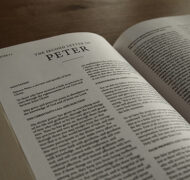2 Peter: Work and New Creation
Bible Commentary / Produced by TOW Project
Second Peter reinforces many of the themes we saw in James and 1 Peter concerning the need for holy living and endurance in suffering. We will not repeat these, but instead discuss only chapter 3, which raises a profound challenge to a theology of work. If “the present heavens and earth have been reserved for fire, being kept until the day of judgment and destruction of the godless” (2 Pet. 3:7), what is the value of our work in the present day? To borrow the title of Darrell Cosden’s important book, what is the heavenly good of earthly work?[1]
The End of the World and the End of Work? (2 Peter 3:1–18)
Back to Table of Contents Back to Table of ContentsDoes our earthly work matter to God? Darrell Cosden has given a resounding “yes” to that question. Central to his argument is the bodily resurrection of Jesus, which (1) affirms the goodness of the material world, (2) demonstrates that there is continuity between the present world and new creation,[1] and (3) is a sign that new creation, while not fully realized, has been initiated. Our work is ultimately valuable because the fruits of our labor, having been redeemed and transformed, will have a home in heaven. But chapter 3 seems to call into question two integral aspects of Cosden’s theology of work: (1) the inherent goodness of created matter, and (2) the continuity between this present world and the world to come, the new creation.
Peter is responding here to lawless scoffers who claimed that God would not intervene in history to judge evil (2 Pet. 3:3–4). He appears to describe a future that lacks all continuity with the present world; instead, it looks like the annihilation of the cosmos:
- "The present heavens and earth have been reserved for fire, being kept until the day of judgment and destruction of the godless.” (2 Pet. 3:7)
- “The heavens will pass away with a loud noise, and the elements will be dissolved with fire, and the earth and everything that is done on it will be disclosed.” (2 Pet. 3:10)
- “All these things are to be dissolved.” (2 Pet. 3:11)
- “The heavens will be set ablaze and dissolved, and the elements will melt with fire.” (2 Pet. 3:12)
- But we should not be too quick to assume that annihilation is really in view here.[2] Peter is using the end-times imagery commonly found in Old Testament prophetic oracles to assure his readers of God’s impending judgment. The Old Testament prophets and Second Temple Jewish literature regularly employed fire imagery metaphorically to refer to both the purging of the righteous and the destruction of all evil.[3]
A reading of 2 Peter 2:7, 10 and 2 Peter 3:12 in keeping with the conventions of apocalyptic literature, would understand the fire and melting imagery as a metaphor for the process in which God separates good from evil.[4] This is how Peter uses fire imagery in his first letter, reminding his readers that, like gold, they too will be tested through fire; those who make it through the fire will be praised and honored by God (1 Pet. 1:5–7). These passages stress not that the heavens and the earth will be literally annihilated, but rather that all evil will be utterly consumed. Likewise, Peter carefully describes the world in terms of transformation and testing: “dissolved,” “melt with fire,” “judgment,” “reserved for fire.” Douglas Moo points out that the word Peter uses for “dissolved” in 2 Peter 3:10–12, luō, does not connote annihilation, but instead speaks to radical transformation. He suggests that an alternate translation might be “undone.”[5]
Peter’s reference to the flood of Noah’s time (2 Pet. 3:5–6) should caution us against reading “deluged” to mean total annihilation. The world did not cease to exist, but was purified of all humanity’s wickedness. Humanity’s goodness—limited to Noah, his family, their possessions, and their work of tending the animals on board—was preserved, and life resumed on the physical earth.
Finally, Peter’s positive vision of the ultimate future describes a renewal of the material order: “But, in accordance with his promise, we wait for new heavens and a new earth, where righteousness is at home” (2 Pet. 3:13). This is no thin, disembodied netherworld, but a new cosmos that contains both a “heaven” and an “earth.” In 2 Peter 3:10 we read that “the earth and everything that is done on it will be disclosed.” Disclosed, not destroyed. Thus even after the burning, “works” will remain.
This is not to say that 2 Peter is the chief source for the theology of the eternal value of present work, but only that 2 Peter is consistent with such a theology.[6] While we may not receive as much detail as we would want, clearly for Peter there is some sort of continuity between what we do on earth now and what we will experience in the future. All evil will be utterly consumed, but all that is righteous will find a permanent home in the new creation. Fire not only consumes, it purges. The dissolution does not signal the end of work. Rather, work done for God finds its true end in the new heavens and new earth.





